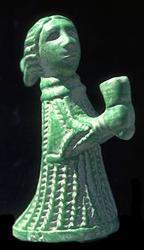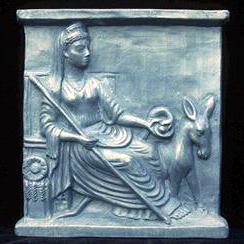



Venus is a Roman goddess principally associated with love, broadly, although not completely, equivalent to Greek Aphrodite and Etruscan Turan. Her cult began in Ardea and Lavinium, Latium. On August 18, 293 BC, her oldest temple was built. August 18 was then a festival called the Vinalia Rustica. On April 1, the Veneralia was celebrated in honor of Venus Verticordia, the protector against vice. On April 23, 215 BC, a temple was built outside the Colline gate on the Capitol dedicated to Venus to commemorate the Roman defeat at the Battle of Lake Trasimene.
Julius Caesar introduced Venus Genetrix as a goddess of motherhood and domesticity.
Venus was often referred to with epithet Venus Erycina ("of the heather").
Venus became a popular subject of painting and sculpture during the Renaissance period in Europe. As a "classical" figure for whom nudity was her natural state, it was socially acceptable to depict her unclothed. As the goddess of sexual healing, a degree of erotic beauty in her presentation was justified, which had an obvious appeal to many artists and their patrons. Over time, "venus" came to refer to any artistic depiction of a nude woman, even when there was no indication that the subject was the goddess.
Vertumnus
The Roman god who watched over the seasons and the garden fruits, he was the husband of Pomona.
Vesta

Vesta: Vesta was the virgin Goddess of household harmony. Her Greek name Hestia means hearth, and from antiquity her vestal virgins tended her sacred altar fire on the Palatine Hill in Rome. Vesta was honored as Rome's First Mother. The serpent sucking an egg from her patera represents her generative role, while her scepter and himation headdress signify her rank. Under her throne is a measure of wheat and a round loaf, as she was the deity of household abundance and well-being. Her consort was the donkey-god Pales, a symbol of fertility throughout the ancient world.
As Goddess of the Hearth she was the symbol of the home, around which a newborn child must be carried before it could be received into the family. Every meal began and ended with an offering to her:
"Vesta, in all dwellings of men and immortals
Yours is the highest honor, the sweet wine offered
First and last at the feast, poured out to you duly.
Never without you can gods or mortals hold banquet."
Each city too had a public hearth sacred to Hestia, where the fire was never allowed to go out. If a colony was to be founded, the colonists carried with them coals from the hearth of the mother-city with which to kindle the fire on the new city's hearth.
The fire was guarded by her priestesses, the Vestales. Every March 1 the fire was renewed. It burned until AD 391, when the Emperor Theodosius I forbade public pagan worship. One of the Vestales was Rea Silvia, who with Mars conceived Romulus and Remus.
The Vestales were one of the few full time clergy positions in Roman religion. They were drawn from the patrician class and had to observe absolute chastity for 30 years (they were also called the Vestal virgins). They could not show excessive care of their person, and they must not let the fire go out. The Vestal Virgins lived together in a house near the Forum (Atrium Vestae), supervised by the Pontifex Maximus. On becoming a priestess, a Vestal Virgin was legally emancipated from her father's authority. If a Vestal broke her vow of chastity before the 30 years were up, she was condemned to be buried alive in the Campus Sceleris ('Field of Wickedness').
The Vestales wore a tunica, a simple dress that they used for both the temple and everyday life (people in Rome usually dressed one way at home and another for the outdoors). In Italian, the vestaglia (dressing-gown) is named after the clothes worn by the Vestales.
Viracocha
The supreme deity of the Incas, Viracocha was a storm god and a sun god. He was represented as wearing the sun for a crown, with thunderbolts in his hands, and tears descending from his eyes as rain. Like Odin, his wandered the earth disguised as a beggar, and wept when he saw the plight of the creatures he had created, but knew that he must sustain them. Viracocha made the earth, the stars, the sky and mankind, but his first creation displeased him, so he destroyed it with a flood, and made a new one.
Vishnu

Vishnu is the archetype of the Husbandman, the All-Pervasive Sustainer Depicted as a mighty king. Vishnu is a kind and adaptable god who works continuously for the world's welfare. Traditionally associated with the sun, he always descends to earth in avataric (bodily) forms when the danger of total destruction is imminent. Here he is protected by the giant Earth-regenerating serpent Ananta. The three best-known of Vishnu's 10 avatars are Rama, Krishna, and Buddha. Others include Narasinha the lion avatar, and Kalki the horseman avatar of Vishnu.
Vithar
The Norse god next in strength to Thor, Vithar was supposed to destroy the Fenris wolf, by placing one foot on the lower jaw, grasping the upper and tearing the wolf's mouth apart.
Volsung
Volsung was of the lineage of Rerir, who was the son of Sigi, who in turn was the son of Odin. Volsung lay in his mother's womb for seven years, and when he was finally born he gave rise to the great and epic Saga of the Volsungs. Volsung's descendants were the great Germanic heroes Sigmund and his son Sigurd.
Vulcan
Vulcan, in Roman mythology, is the son of Jupiter and Juno, and husband of Maia and Venus. He was god of fire and volcanoes, and the manufacturer of art, arms, iron, and armor for gods and heroes. Vulcan's analogue in Greek mythology is the god Hephaestus. He is also called Mulciber ("softener") in Roman mythology and Sethlans in Etruscan mythology. His smithy was believed to be situated underneath Mount Aetna in Sicily. At the Vulcanalia festival, which was held on August 23, fish and small animals were thrown into a fire. Vulcan's shrine in the Forum Romanum, called the Volcanal, appears to have played an important role in the civic rituals of the archaic Roman Kingdom. Vulcan was the father of Caeculus.
To punish mankind for stealing the secrets of fire, Zeus, ordered the other gods to make a poisoned gift for man. Vulcan’s contribution to the beautiful and foolish Pandora, was to mold her from clay and to give her form. He also made the thrones for the other gods on Mt. Olympus.
More Coming.....
